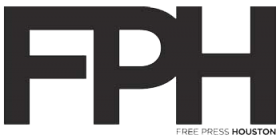By: Meghan Hendley
Photos by Mason Rankin
Living in a concrete jungle means one is always scaling miles of gray highways, constantly soaring over sky high ramps, and as usual tapping our fingers on the steering wheel while we are stuck in bumper to bumper traffic. Glazed over from these perpetual sites, drivers may not notice the subtle shadows and lines that mimic contemporary art that can be found from freeways and major interstate intersections. Artist Mason Rankin, born and raised in Baytown Texas, was struck by the curves and twists of these massive road structures and decided to develop bodies of work around them. “When I was young these forms were monumental and overwhelming,” says Rankin. “As I learned to drive I saw them as the trusted pathways around town similar to trails in a forest. Without knowing who created them, they are accepted as the way to where you may be going.”
This freeway fascination stuck with him and eventually led him to receive a BFA in photography from Sam Houston State University and his MFA in Studio Art from Florida State University. He has taken these forms and turned them into works in photography, sculpture, and video. Today he sees them as an indelible mark on the Americana landscape, constructed to stand for ages. FPH asked him some questions about what makes these modern landscapes so appealing:
Q. Tell us about the concept of using highways and roads in major cities as a focal point for your artwork.
A. I see the freeways, especially the intersections, as monuments of contemporary culture and technological progress. I think they are underappreciated, especially by those who see them every day while passing by at 80MPH. I want my work to provide an opportunity for the viewer to pause and have a moment with them in a way they don’t normally get to.
Q. What first moved you to capture these structures?
A. It started when I moved away for graduate school. Having grown up around Houston the freeways and industry were always part of the landscape. But, when I moved away I missed them greatly. Without those details the landscape felt empty. Because of this, I approached these urban and industrial details in my work so I could present them to viewers who were less familiar with them or don’t normally take the time to observe them.
Q. You have various series in black and white and in color. What is it like with each and how do you process the film?
A. My Black and White work provides a gritty visual of the landscape. I think it fits what more people, who may not be from urban centers, feel about major metropolitan areas. I hand process and print my B&W photographs using traditional chemical processes. I think the freeways are quite beautiful and amazing in many ways. By creating the newer work in accurate natural color, I feel it gives the images the same respect that I have toward the structures. The color work is captured with a large format camera. The negatives are then scanned and printed using current digital technologies.
Q. How have you translated photography into sculptures?
A. I am very interested in the possibilities of using photography as more than just print media. I think it has great potential to be used in three dimensions. Photography is primarily the image capture of 3D objects and sculpture is the creation of 3D objects. The blocks were a way for me to create a sculptural object while using the stereographs to start combining the two. The stereo photography itself makes small sculptural forms by the way our eyes and brains interpret them. That makes this series a set of visual sculptures within physical sculptures.
Q. You currently use your background and skills in the teaching arena. What is it like to teach? Next project?
A. I am really excited to be teaching at the college level. I enjoy the exchange of ideas and the ability to get the students to learn their own ability to express, while at the same time I can continue learning new perspectives from them. I am constantly trying to find new ways to present art to artists and non-artists not only in the classroom but also through other modes. Along with continuing to teach, I would like to engage with art non-profits to help encourage more people to connect with and learn from the arts.
As for my own work, I am working on new ideas that are abstracting both the photographs and their sculptural presentations. My previous work has been a lot about the realistic presentation of the industrial and infrastructural elements. I am back to focusing on the creation of sculptural forms and the possibilities of how photography can become a part of that in an abstracted way.


